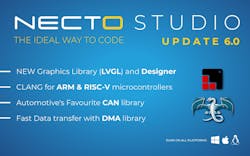IDE for Embedded Apps Adds Enhanced Graphics Library, Expanded Toolchains
MikroElektronika recently released version 6.0 of its NECTO Studio, a complete, cross-platform embedded integrated development environment (IDE) with six new major features. These include an enhanced graphics library with a brand new UI designer, Clang and LLVM toolchains for Arm and RISC-V microcontrollers, CAN support with integrated DMA control, and RTC and LCD (available in the mikroSDK).
According to Nebojsa Matic, CEO of MIKROE, “The latest update to NECTO Studio IDE significantly improves the development experience. Inclusion of LVGL enhances the graphical aspects of projects. Clang for Arm and RISC-V compilers integration, along with LLDB for Arm and RISC-V debuggers, provides powerful tools for code compilation and debugging.
"The IDE now boasts advanced debugging features, such as call stack support for GCC and Clang compilers, a detailed core registers view, and a comprehensive library collection for CAN, DMA, RTC, and LCD within the mikroSDK framework, streamlining the development process.”
The improved LVGL enhanced graphics library with its new UI designer can bring circuits to life for the user, with a blend of algorithmic precision and graphical creative ability. WIth its intuitive drag-and-drop functionality, this IDE update gives developers the ability to create attractive and appealing user-friendly interfaces.
The IDE also has the ability to group and save custom controls to enhance workflow efficiency and project consistency. Multi-screen design support facilitates the development of complex, versatile application solutions that can be ported to adapt to various devices.
Improving the coding experience on multiple platforms by integrating the Clang compiler for Arm and RISC-V architectures, NECTO Studio offers additional features like comprehensive call stack analysis and a detailed core registers view. This makes debugging more intuitive and efficient, while expediting problem identification and resolution in complex projects.
The new two-wire CAN interface in NECTO Studio’s mikroSDK library ensures real-time communication between components, which helps boost performance. The integrated DMA controller enhances system performance, reduces CPU load, and optimizes data transfer to improve device responsiveness and operation.
Nebojsa Matic emphasized that “NECTO Studio 6.0 provides everything necessary to start developing, and prototyping, including Click board applications and GUIs for embedded devices. Rapid software development is easily achieved as developers do not need to consider low-level code, freeing them up to focus on the application code itself.
"This means that changing the MCU or even the whole platform will not require developers to redevelop their code for the new MCU or platform. They can simply switch to the desired platform, apply the correct board definition file, and the application code will continue to run after a single compiling operation.”
Related links:
About the Author
Alix Paultre's Archive
Editor-at-Large
Also check out Alix's main author page for his latest articles.
An Army veteran, Alix Paultre was a signals intelligence soldier on the East/West German border in the early ‘80s, and eventually wound up helping launch and run a publication on consumer electronics for the US military stationed in Europe. Alix first began in this industry in 1998 at Electronic Products magazine, and since then has worked for a variety of publications in the embedded electronic engineering space. Alix currently lives in Wiesbaden, Germany.
Also check out hjis YouTube watch-collecting channel, Talking Timepieces.


